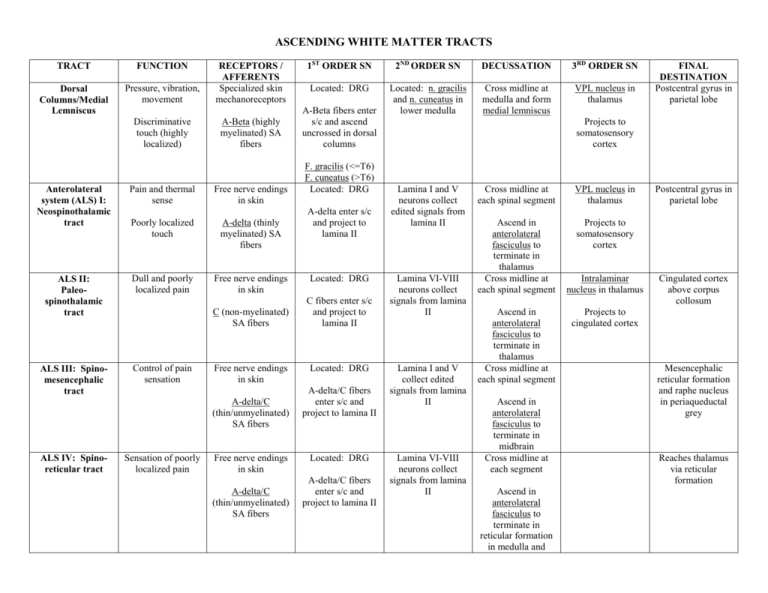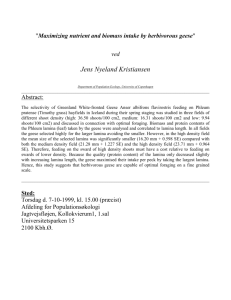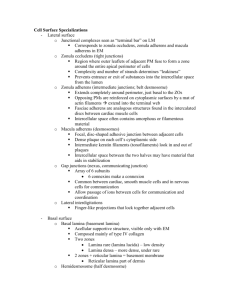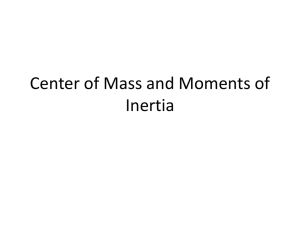ASCENDING WHITE MATTER TRACTS
advertisement

ASCENDING WHITE MATTER TRACTS TRACT FUNCTION Dorsal Columns/Medial Lemniscus Pressure, vibration, movement RECEPTORS / AFFERENTS Specialized skin mechanoreceptors Discriminative touch (highly localized) A-Beta (highly myelinated) SA fibers Anterolateral system (ALS) I: Neospinothalamic tract Pain and thermal sense Free nerve endings in skin Poorly localized touch A-delta (thinly myelinated) SA fibers ALS II: Paleospinothalamic tract Dull and poorly localized pain Free nerve endings in skin ALS III: Spinomesencephalic tract Control of pain sensation C (non-myelinated) SA fibers Free nerve endings in skin A-delta/C (thin/unmyelinated) SA fibers ALS IV: Spinoreticular tract Sensation of poorly localized pain Free nerve endings in skin A-delta/C (thin/unmyelinated) SA fibers 1ST ORDER SN 2ND ORDER SN DECUSSATION 3RD ORDER SN Located: DRG Located: n. gracilis and n. cuneatus in lower medulla Cross midline at medulla and form medial lemniscus VPL nucleus in thalamus A-Beta fibers enter s/c and ascend uncrossed in dorsal columns F. gracilis (<=T6) F. cuneatus (>T6) Located: DRG A-delta enter s/c and project to lamina II Located: DRG C fibers enter s/c and project to lamina II Located: DRG A-delta/C fibers enter s/c and project to lamina II Located: DRG A-delta/C fibers enter s/c and project to lamina II FINAL DESTINATION Postcentral gyrus in parietal lobe Projects to somatosensory cortex Lamina I and V neurons collect edited signals from lamina II Lamina VI-VIII neurons collect signals from lamina II Lamina I and V collect edited signals from lamina II Lamina VI-VIII neurons collect signals from lamina II Cross midline at each spinal segment VPL nucleus in thalamus Ascend in anterolateral fasciculus to terminate in thalamus Cross midline at each spinal segment Projects to somatosensory cortex Ascend in anterolateral fasciculus to terminate in thalamus Cross midline at each spinal segment Ascend in anterolateral fasciculus to terminate in midbrain Cross midline at each segment Ascend in anterolateral fasciculus to terminate in reticular formation in medulla and Intralaminar nucleus in thalamus Postcentral gyrus in parietal lobe Cingulated cortex above corpus collosum Projects to cingulated cortex Mesencephalic reticular formation and raphe nucleus in periaqueductal grey Reaches thalamus via reticular formation ALS V: Anterior spinothalamic tract Crude touch and pressure information Poorly localized and nondiscriminative Dorsal spinocerebellar / cuneocerebellar (DSC) Conveys muscle sense info (strength, phase rate) used by CB to coordinate movt and posture Free nerve endings in skin A-beta/delta (myelinated) SA fibers Muscle spindles and golgi tendon organs A-alpha; Ia/Ib (thick myelinated) SA fibers Located: DRG SA fibers enter s/c and project to lamina I and II Located: DRG SA fibers enter s/c and stay in same side in lateral part of posterior funiculus Collects info about individual muscles Ventral / rostral spinocerebellar tract Conveys to CB integrated info about limb behiavor as a whole from lower limbs (ventral) and upper lims (rostral SCT) Golgi tendon organs A-alpha; IB (thick myelinated) SA fibers Located: DRG A-alpha fibers enter s/c Neurons in dorsal horn generate bilateral output fibers Clarke’s n. (=<C8) External cuneatus (>C8) in medulla (cuneocerebellar tract) pons Some fibers cross, others don’t Ascend in anterolateral fasciulus to terminate in thalamus Ipsilateral (no cross) VPL nucleus in thalamus Postcentral gyrus in parietal lobe Projects to somatosensory cortex Cerebellum (vermis) Ipsilateral Output fibers from 2nd order project to CB via inferior CB peduncle Spinal border cells of lamina V-VII Spinal border cells send axons that corss at each segment and ascend to upper pons where they cross again to reach CB via superior CB peduncle Ends up ipsilateral Cerebellum (vermis) DESCENDING WHITE MATTER TRACTS TRACT FUNCTION ORIGIN 1ST ORDER MN DECUSSATION Cortico-spinal tracts: lateral / anterior Execute and control voluntary / involuntary motor activity Motor and pre-motor cortex in precentral gyrus Projects through internal capsule towards midbrain (Cerebral peduncles), pons, medulla (pyramids) 75-90% cross at pyramidal decussation Produce A-alpha (thick myelinated) efferent fibers Subcortico-spinal (lateral grp): rubrospinal tract Muscle tone control and regulation of voluntary movement Red nucleus in midbrain 2 tracts: Lateral CS: posterior lateral funiculus; 7590% decussated and 90% project to IN of lamina VII and VIII; 10% project to MN of lamina IX of distal muscles Anterior CS: anterior funiculus; only in cervical and upper T levels; innervates axial neck/body muscles; 25-10% cross at midline of each segment Cross midline at ventral tegmental decussation (VTD) CB uses it to make corrects on ongoing movt by modifying MN excitability Subcortico-spinal (lateral grp): raphespinal tract Acts on distal flexors Controls and modulates pain sensation at s/c level Subcortico-spinal (medial grp): tectospinal tract FINAL DESTINATION At s/c, rubrospinal fibers are next to lateral cortico-spinal tract Rubrospinal fibers project on IN in lamina V-VIII (in C and L enlargements) Act on MN through IN networks Dorsal raphe nuclei in midbrain Cross midline locally and descend in s/c next to rubrospinal and lateral cortico-spinal tract Project on IN and SA fibers in lamina I, II, V Superior colliculus in tectus (midbrain) Cross midline at dorsal tegmental decussation (DTD) in midbrain Projects bilaterally to gray matter in anterior horn to IN and MN of axial neck and trunk Related with ALS Release serotonin (5HT) on IN Mediates postural and head motor reflex orienting responses to moving visual stimuli SPINAL PATHWAY penetrating visual fields Subcortico-spinal (medial grp): reticulospinal tract Modulates spinal reflexes thus indirectly MN excitability Subcortico-spinal (medial grp): lateral vestibulospinal tract Regulates muscle tone of axial muscles and posture adjustment Triggers responses to adjust posture and keep balance Subcortico-spinal (medial grp): medial vestibulospinal tract Regulates activity of antigravity extensors in lumbar region (i.e. quads and tibialis anterior) Facilitates flexor MN in upper C levels that control head position according to vestibular info muscles Reticular formation in pons and medulla: Pontine RS tract (medial) & medullar RS tract (lateral) Pontine RS travel uncrossed in medial funiculus Only at upper cervical levels Gray matter interneurons of lamina VII all across s/c Medullary RS bilateral in lateral funiculus Lateral vestibular n. in medulla Uncrossed in medial/lateral funiculus Projects to gray matter MN and IN (lamina VIII and IX) at lumbar level Medial vestibular n. in medulla Descend uncrossed next to midline in medial part of anterior funiculus Gray matter (lamina VIII and IX) at cervical levels on IN and MN of axial muscles Fibers join middle longitudinal fasciculus (MLF) that coordinates eye/head movt according to vestibular info Contiuation of MLF in cervical medulla







